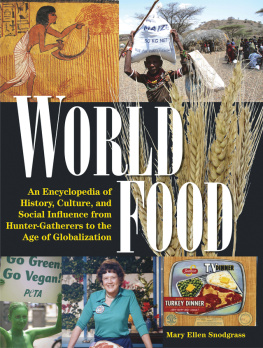Archaeology of Food
Archaeology of Food
An Encyclopedia
Edited by
Karen Bescherer Metheny and Mary C. Beaudry
ROWMAN & LITTLEFIELD
Lanham Boulder New York London
Published by Rowman & Littlefield
A wholly owned subsidiary of The Rowman & Littlefield Publishing Group, Inc.
4501 Forbes Boulevard, Suite 200, Lanham, Maryland 20706
www.rowman.com
Unit A, Whitacre Mews, 26-34 Stannary Street, London SE11 4AB, United Kingdom
Copyright 2015 by Rowman & Littlefield
All rights reserved . No part of this book may be reproduced in any form or by any electronic or mechanical means, including information storage and retrieval systems, without written permission from the publisher, except by a reviewer who may quote passages in a review.
British Library Cataloguing in Publication Information Available
Library of Congress Cataloging-in-Publication Data
Archaeology of food : an encyclopedia / edited by Karen Bescherer Metheny and Mary C. Beaudry.
volumes cm
Includes bibliographical references and index.
ISBN 978-0-7591-2364-9 (cloth : alkaline paper) ISBN 978-0-7591-2366-3 (electronic)
1. Prehistoric peoplesFoodEncyclopedias. 2. Food habitsHistoryEncyclopedias. 3. DietHistoryEncyclopedias. 4. Excavations (Archaeology)Encyclopedias. 5. Social archaeologyEncyclopedias. I. Metheny, Karen Bescherer, 1960 II. Beaudry, Mary Carolyn, 1950
GN799.F6A73 2015
394.1'209dc23
2014049892
 The paper used in this publication meets the minimum requirements of American National Standard for Information SciencesPermanence of Paper for Printed Library Materials, ANSI/NISO Z39.48-1992.
The paper used in this publication meets the minimum requirements of American National Standard for Information SciencesPermanence of Paper for Printed Library Materials, ANSI/NISO Z39.48-1992.
Printed in the United States of America
In memory of our colleagues
Klaus Schmidt19532014
Sharon Zuckerman19652014
Abbreviations
aDNA | ancient DNA |
AMS | accelerator mass spectrometry radiocarbon dating |
BSR | Broad Spectrum Revolution |
C | Carbon-14 or radiocarbon |
cDNA | complementary DNA |
cf. | confer or compare (taxonomic nomenclature) |
CIEP | crossover immunoelectrophoresis |
CT | computed tomography |
DEM | digital elevation model |
DISH | diffuse idiopathic skeletal hyperostosis |
DNA | deoxyribonucleic acid |
EBA | Early Bronze Age |
EDX | energy dispersive X-ray analysis |
ESA | Early Stone Age |
FCR | fire-cracked rock |
FTIR | Fourier transform infrared spectroscopy |
GC/C/IRMS | gas chromatographycombustionisotope ratio mass spectrometry |
GC/GC-MS | gas chromatography/gas chromatographymass spectrometry |
GIS | geographic information system |
HBE | human behavioral ecology |
HPLC | high performance liquid chromatography |
ICP-AES | inductively coupled plasmaatomic emission spectroscopy |
ICP-MS | inductively coupled plasmamass spectrometric analysis |
INAA | instrumental neutron activation analysis |
kcal | kilocalories |
LAB | lactic acid bacteria |
LBA | Late Bronze Age |
LC-MS/MS | liquid chromatographymass spectrometry/mass spectrometry |
LEH | linear enamel hypoplasias |
LiDAR | light detection and ranging |
LP | lactase persistence |
LSA | Late Stone Age |
micro-CT | micro-computed tomography or microtomography |
MNI | minimum number of individuals |
MRI | magnetic resonance imaging |
MSA | Middle Stone Age |
mtDNA | mitochondrial DNA |
n= | number equals |
NAA | neutron activation analysis |
NGS | next generation sequencing |
NISP | number of identified specimens |
PCR | polymerase chain reaction |
PPNA | Pre-Pottery Neolithic A |
PPNB | Pre-Pottery Neolithic B |
pXRF | portable X-ray fluorescence |
qPCR | quantitative polymerase chain reaction |
RNA | ribonucleic acid |
ROV | remotely operated vehicle |
RT-PCR | reverse-transcription polymerase chain reaction |
SAGE | serial analysis of gene expression |
SEM | scanning electron microscopy |
sp./spp. | one or several species unknown or unspecified (taxonomic nomenclature) |
USO | underground storage organ |
var. | variety (taxonomic nomenclature) |
VHR | very high resolution satellite imagery |
VLM | visible-light microscopy |
WTSS | whole transcriptome shotgun sequencing |
XRF | X-ray fluorescence |
Dates
BP | before present |
cal AD | calibrated years AD |
cal BC | calibrated years BC |
cal BP | calibrated years BP |
cal KYA | thousand years ago calibrated |
KYA | thousand years ago |
MYA | million years ago |
Symbols
ca. | circa |
~ | similar to |
< | less than |
> | greater than |
plus or minus |
Introduction
An egg. A ceramic bowl. A stone pestle. Charred grains of wheat. Seemingly ordinary objects that nonetheless have profound implications for understanding past human culture and society. Food procurement is essential to human survival, and changes to diet have been intimately connected with human evolutionary and social development. Ancient populations developed a multitude of strategies (of which food production, or agriculture, is only the most recent) to procure, process, and consume foods for their subsistence. But food is more than diet and nutrition. Food and foodways are central to cultural practice, social organization, and a range of intersecting identities and belief systems.
In editing the first reference work devoted to the fundamental connection between food and archaeology, our chief goal has been to assemble into two volumes entries that succinctly encapsulate current scientific knowledge about the archaeology of food. The encyclopedias 284 entries, contributed by 236 archaeologists and scholars from across the globe, are a reflection of the interest in and breadth of food-related inquiries in our field. The encyclopedia spans diverse geographical and temporal contexts, as well as an array of topics related to the archaeological study of food, including eras, places, cultural groups, specific foodstuffs, landmark sites, analytical techniques, methodology, pioneers in the field, innovations, theories, issues, controversies, and more. Entries such as Bioarchaeological Analysis or Food and Capitalism provide broad overviews of research using examples from different sites, cultures, or eras. More narrowly focused entries, for example, on specific analytical techniques, and site-focused entries provide greater detail.
Next page









 The paper used in this publication meets the minimum requirements of American National Standard for Information SciencesPermanence of Paper for Printed Library Materials, ANSI/NISO Z39.48-1992.
The paper used in this publication meets the minimum requirements of American National Standard for Information SciencesPermanence of Paper for Printed Library Materials, ANSI/NISO Z39.48-1992.